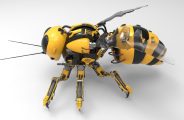Scientist’s Confirm: 2 Common Pesticides Killing American Honey Bees… What Now?

The mystery has been unraveled, after 2 years of research, scientists have disclosed the reason for the demise of the American Honey Bee and it really is no surprise that it the problem is man made.
If you haven’t heard, Honey bees are quickly disappearing from the US in frightening numbers. This phenomenon known as CCD( Colony Collapse Disorder) is a serious problem and could seriously damage the worlds food supply if no resolution is found. The reason for CCD has left scientists baffled for two years. However, new research from the University of Maryland shows that bees exposed to common agricultural chemicals is the primary cause.
As a result of chemical exposure, honey bees are more likely to succumb to the lethal Nosema ceranae parasite and die from the resulting complications.
University of Maryland scientists and the US Department of Agriculture published a study on Wednesday that linked chemicals, including fungicides, to the mass die-offs. Scientists have long struggled to find the cause behind the Colony Collapse Disorder (CCD), in which an estimated 10 million beehives at an average value of $200 each have been lost since 2006.
Last winter, the honey bee population declined by 31.1 percent, with some beekeepers reporting losses of 90 to 100 percent of their bee populations. Scientists are concerned that “Beemageddon” could cause the collapse of the $200 billion agriculture industry, since more than 100 US crops rely on honey bees to pollinate them.
Dennis van Engelsdorp, an EPA Study Manager explained that federal regulations restrict the use of insecticides while pollinators are foraging, but noted that “there are no such restrictions on fungicides, so you’ll often see fungicide applications going on while bees are foraging on the crop. The finding suggests that we have to reconsider that policy.”
Bees are declining at such a fast rate that one bad winter could trigger an agricultural disaster. California’s almond crop would be hit particularly hard, since the state supplies 80 percent of the world’s almonds. Pollinating California’s 760,000 acres of almond fields requires 1.5 million out-of-state bee colonies, which makes up 60 percent of the country’s beehives. The CCD is a major threat to this $4 billion industry.
Entomologists suspect that a number of other factors also contribute to the CCD, including climate change, habitat destructing and handling practices that expose bees to foreign pathogens. But the effect of agricultural chemicals is particularly alarming, especially since the US does not have laws banning the use of the pesticides that are affecting bee health.
“The pesticide issue in itself is much more complex than we have led to believe,” van Engelsdorp said. “It’s a lot more complicated than just one product, which means of course the solution does not lie in just banning one class of product.”
via Reuters
















































